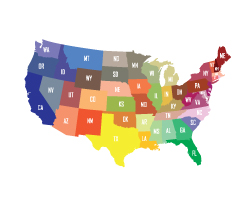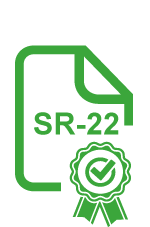Just because you have been convicted of a felony doesn’t mean you must carry around that conviction forever. Contact a skilled attorney who knows the laws regarding criminal pardons and criminal rehabilitation. This could be the most important contact you ever make. Criminal rehabilitation can clear your record and help you get your life back.
In California, there are two ways that someone sentenced to state prison can obtain relief: the Certificate of Rehabilitation and Pardon, and the Direct Application for Pardon.
A full criminal pardon, whether direct or through criminal rehabilitation proceedings, restores all of the rights and privileges of which the person was deprived by reason of the conviction, with some exceptions. In addition, a pardon relieves a sex offender of the duty to register under Penal Code Section 290. But a criminal pardon does not automatically restore any license, permit, or certificate that had been taken as the result of the conviction.
A governor’s pardon is granted only to individuals who have demonstrated a high standard of constructive behavior following a conviction for a felony, or in some cases, for certain specified misdemeanor sex offenses. Obtaining a criminal pardon is a distinct achievement based upon proof of a useful, productive, and law-abiding life following conviction.
Criminal pardon applications will not be considered unless an applicant has been discharged from probation or parole for at least 10 years and has not engaged in further criminal activity during that period. While the receipt of a Certificate of Rehabilitation will be considered in evaluating a criminal pardon application, it is but one factor and is not the sole determinant. The 10-year rule may be waived in truly exceptional circumstances if the applicant can demonstrate an earlier, specific need for the criminal pardon.
Once the threshold criteria have been met, the application will be reviewed to determine whether the applicant has met the standards set forth in California Penal Code section 4852.05, which states, “During the period of rehabilitation, the person shall live an honest and upright life, shall conduct himself or herself with sobriety and industry, shall exhibit a good moral character, and shall conform to and obey the laws of the land.”
Certificate of Criminal Rehabilitation
Certificates of Rehabilitation are first sought from the trial court. If a certificate issues, the trial court recommends that the governor grant a criminal pardon. The governor has discretion to grant or deny a criminal pardon. The criminal pardon may be granted without further investigation, except in instances where a person twice convicted of felonies must also have the recommendation of a majority of the state supreme court.
In order to obtain a Certificate of Rehabilitation, the applicant must be a California resident for at least three years before the filing of the petition. There is a period of criminal rehabilitation that is required before filing, during which the person must lead an honest life and be free from convictions. The amount of time varies, depending upon the underlying criminal conviction.
Dismissal of the underlying charges pursuant to Penal Code Section 1203.4 is not required before seeking a Certificate of Rehabilitation, so long as the person served a prison sentence. If probation was imposed instead of a prison sentence, dismissal must first be obtained, and the defendant must be free from felony probation.
A Certificate of Rehabilitation is a court order, which declares that a person who has been convicted of a felony is rehabilitated. If a petition for a Certificate of Rehabilitation is granted, it is forwarded to the governor by the granting court and constitutes an application for a criminal pardon.
The laws pertaining to the Certificate of Rehabilitation can be found in California Penal Code sections 4852.01 to 4852.21.
Generally, a person who has been convicted in California of a felony, or a misdemeanor sex offense specified in California Penal Code section 290, the accusatory pleading of which has been dismissed pursuant to Penal Code section 1203.4, may apply to the superior court in his or her county of residence for a Certificate of Rehabilitation, provided that he or she meets behavioral requirements and the applicable period of criminal rehabilitation. (California Penal Code section 4852.06.)
An exception to this rule involves individuals convicted of the following Penal Code sections: 286(c), 288, 288a(c), 288.5, and 289(j). Effective January 1, 1998, AB 729 amended Penal Code sections 1203.4 and 4852.01 to prohibit these specified sex offenders from obtaining a Certificate of Rehabilitation. Such individuals are no longer eligible to receive a Certificate of Rehabilitation.
The granting of a Certificate of Rehabilitation relieves some offenders from the sexual offender registration requirement of Penal Code section 290. (See California Penal Code section 290.5 for a list of persons not eligible for relief from registration.) To determine your 290 registration status, contact an attorney that knows the law in this specialized area.
Who May Apply for a Criminal Pardon?
Persons who are eligible to apply for a Certificate of Rehabilitation include those who:
- Were convicted of a felony and served the sentence in a California state prison; and
- Were discharged on completion of the term or released on parole prior to May 13, 1943; and
- Have not been incarcerated in a state penal institution since release; and
- Present satisfactory evidence of three years of residence in California immediately prior to the filing of the petition.
or
- Were convicted of a felony, or a misdemeanor sex offense specified in Penal Code section 290, the accusatory pleading of which was dismissed pursuant to Penal Code section 1203.4; and
- Have been discharged or released from custody on probation; and
- Have not been incarcerated in any penal institution, jail, or agency since the dismissal of the accusatory pleading; and
- Are not on probation for the commission of any other felony; and
- Present satisfactory evidence of five years of residence in California immediately prior to the filing of the petition.
or
- Were convicted of a felony on or after May 13, 1943; and
- Were sentenced to state prison or other institution or agency; and
- Were discharged from custody or released on parole; and
- Present satisfactory evidence of five years of residence in California immediately prior to the filing of the petition.
Persons who are INELIGIBLE to apply for a Certificate of Rehabilitation include:
- Those who do not meet the above requirements; or
- Those who were convicted only of misdemeanors (except those convicted of a misdemeanor sex offense specified in Penal Code section 290, which was dismissed pursuant to Penal Code section 1203.4); or
- Those who were convicted of Penal Code sections 286(c), 288, 288a(c), 288.5, or 289(j); or
- Those who are serving mandatory life parole; or
- Those committed to prison under a death sentence; or
- Those persons in the military service.
When Should I Apply for Criminal Rehabilitation?
Persons eligible to petition for a Certificate of Rehabilitation may file the petition once the period of criminal rehabilitation has passed. The period of criminal rehabilitation begins to run upon the discharge of the petitioner from incarceration due to the completion of the term, or upon release on probation or parole.
The period of rehabilitation constitutes five years residence in California, PLUS:
- Four years in the case of persons convicted of a violation of California Penal Code sections 187, 209, 219, 4500, or 12310, or Military and Veterans Code section 1672(a), or of committing any other offense which carries a life sentence; or
- Five years in the case of any person convicted of any offense or attempted offense for which sex offender registration is required pursuant to P.C. 290, except for convictions for violations of subdivision (b), (c), or (d) of Section 311.2, or of Section 311.3, 311.10, or 314. For those convictions, two years shall be added to the five years imposed by this section.
- Two years in the case of any persons convicted of any offense not listed above and which does not carry a life sentence; or
- The number of additional years ordered by the trial court hearing the application for the Certificate of Rehabilitation in the case of a person serving consecutive sentences.
Can a Criminal Rehabilitation Certificate Be Taken Away?
A district attorney in either the county of conviction or the county of residence may petition the superior court to rescind a certificate if it was granted for any offense specified in California Penal Code section 290.
How to Apply for Criminal Rehabilitation
The petition must be filed in the superior court of the petitioner’s current county of residence. (California Penal Code section 4852.06.) Petitioners are required to provide notice of their filing to the district attorney in their county of residence, as well as to the district attorney of each county in which the petitioner was convicted of a felony, and to the governor’s office.
All felony convictions, or misdemeanor sex offenses specified in Penal Code section 290, for which the accusatory pleading was dismissed pursuant to California Penal Code section 1203.4, should be included. This notice must indicate the date and time of the hearing and must be sent to the district attorneys at least 30 days before the hearing.
Each person who is eligible to initiate the Certificate of Rehabilitation proceedings is entitled to receive assistance in processing the petition from all criminal rehabilitative agencies, including adult probation officers of the county and state parole agents; and, in the case of persons under the age of 30, assistance can be obtained from the Youth Authority. During the court proceedings, the petitioner may be represented by counsel of his or her own choosing.
Once a petition is filed, the court will schedule a hearing to consider the criminal rehabilitation petition. Prior to the hearing, the court may require an investigation by the district attorney of the county of residence of any and all matters pertaining to the petitioner.
At the hearing, the court may require testimony and the production of records and reports pertaining to the petitioner, including information about the conviction offense, and his or her conduct both while incarcerated and since release on probation or parole.
If, after the hearing, the court finds that the petitioner has demonstrated rehabilitation and fitness to exercise all political and civil rights, the court may make an order declaring that the petitioner is rehabilitated. A certified copy of the Certificate of Rehabilitation is then transmitted to the governor and becomes an application for a criminal pardon.
Upon receipt of the application, the governor may request that the Board of Prison Terms conduct a further investigation. Following a review, the governor may then grant the criminal pardon. If the petitioner has been convicted of more than one felony in separate proceedings, the California Supreme Court must also approve the grant of a criminal pardon.
Applying Directly for a Criminal Pardon
Direct pardons refer to requests for criminal pardon made directly to the governor. The governor has total and complete discretion to grant or deny a criminal pardon. The criminal pardon may be granted without further investigation, except that a person twice convicted of felonies must also have the recommendation of a majority of the supreme court to obtain a criminal pardon.
A direct criminal pardon is usually sought by persons who are not eligible for a certificate of criminal rehabilitation, such as nonresidents and those convicted of misdemeanors.
Any person who has been convicted in California of a felony, or a misdemeanor sex offense specified in Penal Code section 290, the accusatory pleading of which has been dismissed pursuant to Penal Code section 1203.4, may apply to the governor for a criminal pardon. Applications for criminal pardons may be made in one of two ways: either by way of an application for a Certificate of Rehabilitation or through a direct traditional criminal pardon application. The procedure utilized will depend on the circumstances of the applicant, and it is important to consult with a lawyer to determine which is appropriate in any given case.
Once an application for a pardon is filed under either procedure, the Governor reviews the case. The Governor has complete discretion in deciding whether to grant a pardon, and a pardon is not granted to every person who applies.
Criminal pardon investigations are conducted for the governor by the California Board of Prison Terms, Investigations Division.
The traditional criminal pardon procedure is available to those persons who are ineligible to petition for a Certificate of Rehabilitation. This procedure is used primarily, although not exclusively, by California ex-felons who reside out-of-state and are therefore unable to satisfy the residency requirement. The traditional criminal pardon procedure is also available to those individuals who have convictions for Penal Code sections 286(c), 288, 288a(c), 288.5, and 289(j). The traditional criminal pardon procedure is covered by California Penal Code sections 4800-4813.
Applicants for a traditional criminal pardon must write directly to the governor’s office. It is highly recommended that a criminal pardon applicant have the services of an experienced lawyer to ensure that all of the procedural requirements are met and to increase the chances of success. At a minimum, the letter should include the following:
- Why a criminal pardon is desired or needed;
- Date and circumstances of all felony offenses of which the applicant was convicted;
- Dates the applicant was received in prison and released from custody or placed on probation;
- Name of the applicant, including any aliases; date of conviction; county and case number of conviction, if known; prison number; the name of parole agent; current address and telephone number; and
- A brief, general statement of employment and activities since conviction or release from custody.
Upon receipt of the letter, the governor’s legal affairs staff will review the information. After the review, the legal affairs office may send the Application for Executive Clemency and Notice of Intention to Apply for Executive Clemency forms to the applicant.
The applicant should complete the Application for Executive Clemency form and have it notarized. In addition, the Notice of Intention to Apply for Executive Clemency should be served on the district attorney of each county in which the applicant was convicted of a felony, at least 10 days prior to the application.
The Acknowledgment of Receipt portion of the notice form must be completed and signed by the district attorney. Both the application and the completed notice must then be submitted to the governor’s office, along with a full statement of any compensation paid to any person for assisting in the procurement of a criminal pardon.
Once the formal application is returned, the governor refers it to the Board of Prison Terms for investigation. After the investigation, the case is presented to the Executive Board for a decision as to whether to recommend to the governor that a criminal pardon be granted. The applicant is notified of when the board will be considering his or her case, and he or she is given the opportunity to forward any additional information if desired. Criminal pardon applicants do not attend the criminal pardon consideration meeting. Following the meeting, the application, investigation report, and the board’s recommendation are sent to the governor. Notification of the meeting result is also sent to the applicant.
The governor then reviews all of the information and decides whether to grant a criminal pardon. If the applicant has been convicted of more than one felony in separate proceedings, the California Supreme Court must also approve the grant of a criminal pardon.
There is no requirement that the governor issue a criminal pardon to an applicant, and the length of time needed for the completion of the criminal pardon process cannot be predicted.
The Effects of a Criminal Pardon
When a Certificate of Rehabilitation or criminal pardon is granted, the California Department of Justice and the Federal Bureau of Investigation are notified. These agencies’ records are then updated to show that a Certificate of Rehabilitation or a criminal pardon has been granted in regard to the conviction.
A criminal pardon is also filed with the Secretary of State, reported to the Legislature, and becomes a matter of public record. Although no effort is made to publicize the criminal pardon application or issuance, there is no guarantee that the issuance of a criminal pardon to a particular person will not become known to the public.
Restoring Your Rights
The granting of a criminal pardon entitles the applicant to exercise additional civil and political rights of citizenship. The most frequent reasons people apply for a criminal pardon are for personal satisfaction, for licensing or bonding purposes, and to restore firearms privileges. Another frequent reason is to enhance employment opportunities, even when no legal disability exists.
A criminal pardon does not seal or expunge the record of the conviction. (California Penal Code section 4852.17.) Prior convictions may be considered after the granting of a criminal pardon if the person is subsequently convicted of a new offense.
A person who has been pardoned cannot state that he or she has no record of arrests or convictions. The person can state that he or she has been convicted and has been pardoned.
An ex-felon becomes eligible to vote after being terminated from probation or discharged from parole. (California Constitution, article 11, section 4.) A criminal pardon is not necessary to be eligible to vote.
A person who receives a criminal pardon may serve on a trial jury. (California Code of Civil Procedure section 203(a)(5) and California Penal Code section 4852.17.)
An ex-felon who receives a full and unconditional criminal pardon can be considered for an appointment to a peace officer position as a county probation officer or state parole agent, but cannot hold other peace officer positions. (California Government Code section 1029.)
A person convicted of a felony cannot own, possess, or have access to any type of firearm, including a rifle or shotgun. (California Penal Code section 12021.) However, if a full and unconditional criminal pardon is granted by the governor, the person pardoned may own and possess any type of weapon that may lawfully be possessed and owned by other citizens in California. The governor cannot restore firearms rights to a person who has been convicted of any offense which involved the use of a dangerous weapon.
Criminal pardons for out-of-state residents must specifically state that rights pertaining to firearms are restored. A California criminal pardon does not necessarily permit the possession of weapons under the laws of another state or the federal government. The law pertaining to the restoration of rights to own and possess firearms can be found in California Penal Code section 4854.
If you have not obtained a criminal pardon restoring your firearms rights, and you have access to a firearm of any type, you are in violation of the law. For example, having a firearm registered to a spouse, but readily available to you in your place of residence, is a violation.
The granting of a criminal pardon does not prevent some licensing agencies from considering the conviction that has been pardoned in its determination of whether a license to practice certain professions should be granted or restored. The law pertaining to the effect of a full criminal pardon on licensing boards can be found in California Penal Code section 4853.







